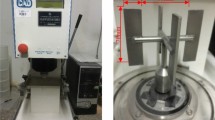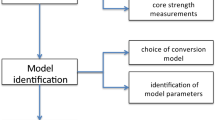Abstract
Several methods were proposed in the past to measure concrete bleeding, but none of them gives complete satisfaction. The method presented herein consists in sucking water with a pipette, in tracks made on the top surface of concrete just after casting. It takes water evaporation into account. Three tests are carried out simultaneously with three samples of different initial heights. Comparison of the results leads to know whether bleeding is localised (in channels) or not. The average bleeding rate of tests that exhibit no channel is the major result of the test; it is found to be rather repeatable. Overall, this method is believed to be more accurate than the previous ones, since any movement of the sample is avoided during test. Also, a double weighing of water is carried out.
Résumé
Plusieurs méthodes ont été proposées pour mesurer le ressuage d'un béton, cependant, aucune d'elles n'est complètement satisfaisante. La méthode que nous proposons dans cet article consiste à aspirer l'eau de ressuage avec une pipette dans des sillons préalablement tracés à la surface du béton après coulage. La méthode tient compte de l'évaporation par une double pesée. Trois essais sont menés simultanément dans trois moules de différente hauteur. La comparaison des résultats obtenus permet de savoir si une localisation du ressuage fut présente. La moyenne des vitesses de ressuage non localisées est le principal résultat de l'essai. Sa répétabilité est assez bonne et semble donner des résultats plus précis qu'avec les autres essais.
Similar content being viewed by others
References
Powers, T.C., ‘The Properties of Fresh Concrete’, (J. Wiley & Sons, Inc., New York, U.S.A., 1968) 533–652.
Giaccio, G. and Giovambattista, A., ‘Bleeding: evaluation of its effects on concrete behaviour’,Mater. Struct. (RILEM)112 (July–August) 1986) 265–271.
Tan, T.S., Loh, C.K., Yong, K.Y. and Wee, T.H., ‘Modelling of bleeding of cement paste and mortar’,Advances in Cement Research 9 (34) (April 1997) 75–91.
Josserand, L., ‘Bleeding of concrete’, PhD thesis of École Nationale des Ponts et Chaussées, 2002 [only available in French] 210 p.
Loh, C.K., Tan, T.S., Yong, K.Y. and Wee, T.H., ‘An experimental study on bleeding and channelling of cement paste and mortar’,Advances in Cement Research 10 (1) (January 1998) 1–16.
Clear, C.A. and Bonner, D.G., ‘Settlement of fresh concrete— An effective stress model’,Magazine of Concrete Research 40 (142) (March 1988) 3–12.
Khayat, K.H. and Guizani, Z., ‘Use of viscosity-modifying admixture to enhance stability of fluid concrete’,A.C.I. Materials Journal 4 (94) (July 1997) 332–340.
ASTM, ‘Standard test methods for bleeding of concrete’, ASTM C232-87, 1987, 144–147.
Swedish standard, ‘Method for measuring water-separation (Bestämning av betongmassas vattenseparation)’, B5-33, 1965 [only available in Swedish].
Sawaide, M. and Iketani, J., ‘Rheological analysis of the behaviour of bleed water from freshly cast mortar or concrete’,A.C.I. Materials Journal 4 (89) (July 1992) 323–327.
Kaplan, D., ‘Pompage des bétons (Concrete pumping)’, Études et recherches des Laboratoires des Ponts et Chaussées, OA 36, March 2001 [in French] 228 p.
Josserand, L. and de Larrard, F., ‘Experimental study of scale effect in fresh mortar bleeding’, Proceedings of the International Congress of Dundee, September 2002, 819–826.
Author information
Authors and Affiliations
Additional information
Editorial note Dr. François de Larrard is a RILEM Senior Member. He works at LCPC, a RILEM Titular Member.
Rights and permissions
About this article
Cite this article
Josserand, L., de Larrard, F. A method for concrete bleeding measurement. Mat. Struct. 37, 666–670 (2004). https://doi.org/10.1007/BF02480511
Issue Date:
DOI: https://doi.org/10.1007/BF02480511




